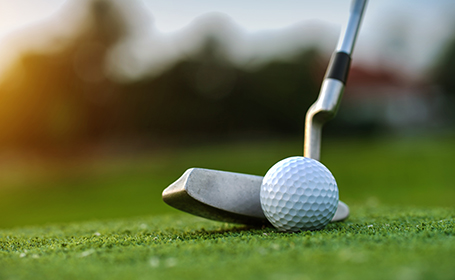
How to prevent golf injuries
Golf expert Jordan Fuller shares his top tips for preventing injuries on the golf course, from correcting your posture to the importance of warming up. Jordan Fuller is an experienced golfing coach and the founder of Golf Influence, a website dedicated to sharing practical, no-nonsense advice on improving your game. The beautiful thing about golf is that you can be successful using a variety of swings and setups. But what all those unique styles have in common is the potential to be hard on your body. You don’t have to look very far to see the toll that golf can take on certain areas of the body. The back is an obvious example. Tiger Woods has undergone four back surgeries to get back on the course after injuries almost cut short his career
Although you can’t eliminate the possibility of injury altogether, there are strategies that you can adopt to minimise your risk. In my experience, the most important things to do are to correct your posture, to make sure your balance and swing are correct, and to warm up properly.
One of the biggest mistakes that amateur golfers make is slouching over the golf ball before they swing.
Improving your posture on the golf course
Using the correct posture on the course is the first step in avoiding injuries. Not only is this great for your body, it also helps your golf game tremendously.
One of the biggest mistakes that amateur golfers make is slouching over the golf ball before they swing. By slouching, you are not allowing your hips to make a complete turn away from the golf ball. This limits the power and the distance you can achieve.
Slouching or hunching over the ball can also lead to strain on your back or neck.
A fundamentally sound golf swing comes from keeping your back straight at address. Following this rule doesn’t mean that you are rigid or inflexible, but the last thing you want to show on that first tee is a rounded back with stiff hips.
The way to make sure that you are keeping good form is by using your hips to rotate into position at address and not the back. This will give you better posture.
Here’s an easy guide to help you work towards correct form:
- Find a full-length mirror and stand straight in front of it. With your hands, find the joints of your hips
- With your fingertips, press into the joints. Meanwhile, move your backside and hips behind your centreline while keeping your back straight and lowering it slightly into a comfortable position
- While you are doing this, remember to keep your shoulder blades even and flat while flexing your knees slightly
If you don’t feel relaxed and comfortable while doing this position, it is a sign that your posture has been affecting you, potentially leading to a poor swing. This positioning drill is a great way to get you aligned while working on growing a better posture.

Improving your swing to avoid golfing injuries
So, let’s jump forward and say that your posture is excellent and you understand the proper position. The next step is to address your swing, taking steps to make sure you are balanced throughout the movement.
As mentioned, good posture is key to a good swing, and following my tips for correcting your stance should naturally improve yours.
However, you should also consider the smoothness and consistency of your swing, trying to make sure you’re not putting particular strain on one muscle or joint. This frequently leads to elbow and wrist injuries in golfers.
Tips for a balanced golf swing:
- Stand with your feet roughly shoulder-width apart. Keep your spine straight and those knees flexed
- Remember, your hips are the driving force of the swing. Not your arms or your shoulders. They should rotate around your spine, not the other way around
- When you are at the top of the swing, your hips should fire forward as you release the torque of the backswing and the body comes back around and unleashes your power onto the golf ball. Aim to keep your left arm straight
A great way to make sure that you are staying aligned is by videoing yourself while doing this drill (without a golf club). Watching it back will help you identify problems, correct them and, put simply, play golf better.
An important part of reducing your risk of injury on the golf course is establishing an effective warm-up routine.
A warm-up to avoid common golf injuries
An important part of reducing your risk of injury on the golf course is establishing an effective warm-up routine.
These are my three recommendations that will help make sure you properly warm up your muscles. This helps to increase your flexibility and reduce the wear and tear that a round of golf places on your body, both of which can reduce the risk of injury.
1. Arrive early
The worst thing that most amateurs do is to show up to the course roughly 15 minutes before a round, take a few practice swings and then hit the first tee. This routine is a recipe for injury.
Instead, try getting to the course roughly 45-60 minutes before your tee time.
Not only are you giving yourself plenty of time to warm up, but you aren’t pushing yourself, so you should feel more relaxed before the round.
2. Stretch (slowly)
The aim here is to focus on flexibility and priming your muscles for a day on the course.
It’s best to work through a routine of several stretches that you feel comfortable performing. You want these stretches to hit all of the essential areas, so think of moves that warm up your back, shoulders, and legs.
My idea of a great pre-golf workout would include:
- Cross-arm stretches that work your shoulders
- Touching your toes to stretch your hamstrings
- Using a tension band to work your back muscles
- Always stay within your comfort zone while doing these stretches, making sure not to overdo them and potentially hurt yourself before you play.
3. Hit at least 25 practice shots
Once you get to the course, grab some practice balls and hit at least 25 shots on the range.
Don’t immediately reach for a wood but work up slowly starting with your wedge, making your way through several irons before finishing with a few full swings with the driver.
Don’t rush your practice. The reason that you got to the course early is so that these shots can be spaced out with plenty of rest in between.
Visualize each shot before you hit it and work on keeping the proper technique as discussed above.
Posture. Swing. Warm-up. Get these right and not only will you be lowering your risk of injury, you’ll also be improving your game.
Read more golf tips from Jordan Fuller on Golf Influence.
Tags
How do I book an appointment?
If you're concerned about symptoms you're experiencing or require further information on this subject, talk to a GP or see an expert consultant at your local Circle Hospital.